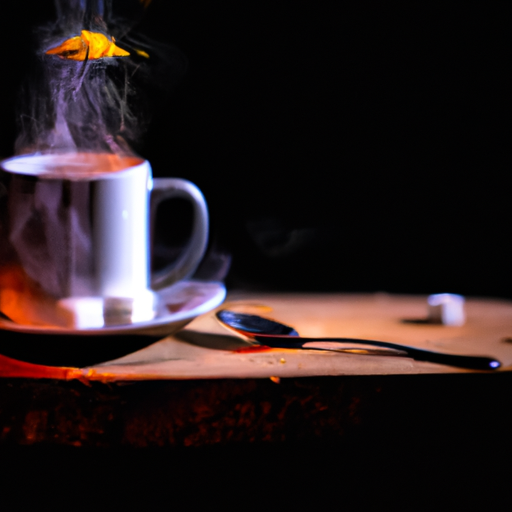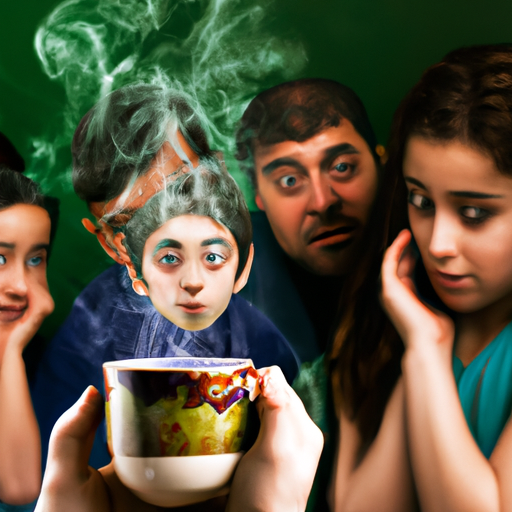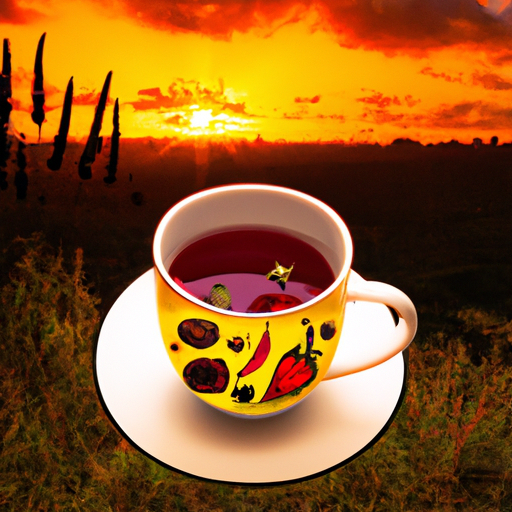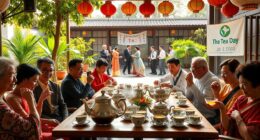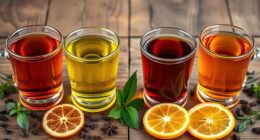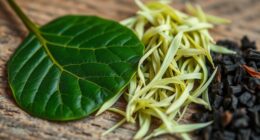Have you ever wondered how a simple cup of herbal tea can transport you to a world of relaxation and rejuvenation? Well, let me tell you, steeping herbal tea is an art form that requires precision and finesse.
It’s like coaxing the delicate flavors and aromas from the leaves, allowing them to unfurl and infuse the hot water with their healing properties. Trust me, getting the steeping time just right can make all the difference in the world.
In this article, I will guide you through the intricacies of steeping herbal tea, sharing my knowledge and expertise gained through countless experiments and a profound love for tea. We will delve into the basics of steeping, explore the factors that affect steeping time, and uncover tips and tricks to enhance the flavor of your brew.
So grab your favorite blend, sit back, and let’s embark on a journey to unlock the secrets of the perfect cup of herbal tea.
Key Takeaways
- Steeping herbal tea requires precision and finesse, with steeping times ranging from 3-10 minutes depending on the tea type and desired strength.
- Different herbal teas have different steeping times, with chamomile and lavender requiring 5-7 minutes, peppermint and hibiscus needing 3-5 minutes, and ginger requiring 7-10 minutes.
- Factors such as water temperature, teapot material, and the quality of herbs and flowers used can affect the flavor of the tea.
- Adjusting steeping times and water temperature according to personal taste preferences can enhance the flavor of herbal tea.
Understanding the Basics of Steeping
You’ll want to steep your herbal tea for about 5-7 minutes to extract all the natural goodness and flavor. Steeping is the process of infusing the tea leaves in hot water, allowing them to release their aromatic oils and beneficial compounds.
The time it takes to steep herbal tea can vary depending on factors such as the type of tea and the desired strength of the brew.
Experimenting with water temperature is an important aspect of steeping herbal tea. Different types of herbal tea require different water temperatures to bring out their optimal flavors. For example, delicate herbal teas like chamomile or mint are best steeped in water that’s around 175°F (80°C). On the other hand, robust herbal teas like hibiscus or ginger can withstand higher temperatures of around 200°F (93°C).
In addition to water temperature, steeping times also play a crucial role in achieving the perfect cup of herbal tea. Steeping for too short a time may result in a weak and insipid brew, while steeping for too long can lead to a bitter and overpowering taste. By experimenting with different steeping times, you can find the sweet spot that suits your personal preference and brings out the best flavors in your herbal tea.
With the basics of steeping understood, let’s now delve into the art of experimenting with steeping times to further enhance your herbal tea experience.
Experimenting with Steeping Times
As I’m experimenting with different steeping times, I imagine the flavors blossoming and intertwining like a delicate dance.
It’s fascinating to see how each herbal tea reacts to varying steeping times. One important aspect to consider when experimenting with steeping times is the temperature of the water. Different temperatures can bring out different flavors in herbal teas.
For example, a lower temperature of around 160°F to 170°F is ideal for delicate herbal teas like chamomile or lavender, as it allows the flavors to gently infuse without becoming overpowering. On the other hand, stronger herbal teas like peppermint or ginger can benefit from a higher temperature of around 190°F to 200°F to bring out their robust flavors.
Another aspect to explore is the effects of prolonged steeping. While some herbal teas can handle longer steeping times without becoming bitter, others may become overly strong or develop a bitter taste. It’s important to find the right balance for each type of herbal tea.
By experimenting with different steeping times, you can find the perfect duration that suits your personal taste preferences.
As we move on to the next section about factors affecting steeping time, we’ll explore additional elements that can influence the infusion process.
Factors Affecting Steeping Time
The dance of flavors in a cup of steeped goodness can be influenced by various factors, like the temperature of the water and the type of leaves used. When it comes to herbal tea, the flavor profile is delicate and can easily be affected by the steeping time. The longer you steep the tea, the stronger the flavors become. However, it’s important to find the optimal steeping time to achieve the desired taste.
One of the factors influencing flavor is the type of leaves used. Different herbs and botanicals have different flavors and characteristics. Some herbs, like chamomile or mint, release their flavors quickly and can become bitter if steeped for too long. On the other hand, herbs like lavender or rose petals may require a longer steeping time to fully release their delicate flavors.
Another important factor is the water temperature. The optimal water temperature for steeping herbal tea is typically between 175°F and 205°F (79°C and 96°C). Steeping herbal tea in water that’s too hot can result in a bitter or astringent taste, while using water that’s too cool may not fully extract the flavors from the leaves.
Understanding these factors and experimenting with different steeping times will help you find the perfect balance for your herbal tea. Now, let’s move on to some tips for steeping herbal tea to enhance your tea-drinking experience.
Tips for Steeping Herbal Tea
When it comes to steeping herbal tea, there are a few important tips to keep in mind. First, use a tea infuser or strainer to ensure you get a perfectly brewed cup every time.
Secondly, choose the right teapot to make a big difference in the flavor and aroma of your tea.
And finally, it’s important to avoid oversteeping your tea, as this can result in a bitter taste.
By following these tips, you can enjoy a delicious and satisfying cup of herbal tea.
Using a Tea Infuser or Strainer
To achieve the perfect infusion of flavors, steep your herbal tea using a tea infuser or strainer for the recommended amount of time. Tea infusers are a great tool for steeping herbal tea because they allow the tea leaves or herbs to expand and release their flavors fully.
There are different types of tea infusers available, such as ball infusers, basket infusers, and spoon infusers. Each type has its own benefits, so you can choose the one that suits your preferences.
On the other hand, tea strainers are another option for steeping herbal tea. They’re usually made of stainless steel or mesh and are used to strain out the tea leaves or herbs after steeping.
Now that you know how to steep your herbal tea with a tea infuser or strainer, let’s move on to choosing the right teapot for the best tea experience.
Choosing the Right Teapot
Selecting the perfect teapot is essential for creating a truly delightful tea experience. When it comes to choosing a teapot, there are a few factors to consider: teapot materials and teapot size. The material of the teapot can affect the taste and brewing process. Ceramic teapots are popular as they distribute heat evenly, while glass teapots allow you to see the infusion process. Size also matters, as a larger teapot is ideal for brewing herbal tea for a group, while a smaller teapot is perfect for individual use. To help you visualize the options, here’s a table that compares different teapot materials and sizes:
| Material | Pros | Cons |
|---|---|---|
| Ceramic | Even heat distribution | Can be fragile |
| Glass | Allows visual infusion process | Heat retention may be lower |
| Stainless Steel | Durable and easy to clean | May affect taste |
By selecting the right teapot, you can enhance the flavor of your herbal tea. Now, let’s explore how to avoid oversteeping and ensure a perfect brew every time.
Avoiding Oversteeping
Achieve a perfect brew every time by mastering the art of timing and preventing excessive infusion. When steeping herbal tea, it’s crucial to avoid oversteeping in order to avoid bitterness and maximize flavor.
Oversteeping can result in a strong, unpleasant taste that masks the delicate flavors of the herbs. To prevent this, simply follow the recommended steeping time for your specific herbal tea. Generally, herbal teas should be steeped for around 5 to 7 minutes. However, keep in mind that different types of herbal teas may require different steeping times, so always refer to the instructions on the packaging.
By carefully timing your steeping process, you can ensure a well-balanced and flavorful cup of herbal tea.
Transitioning into the next section, let’s explore how to enhance the flavor of herbal tea without adding any additional ingredients.
Enhancing the Flavor of Herbal Tea
Steeping herbal tea just long enough can really bring out its delicious flavors. When it comes to enhancing the flavor of herbal tea, there are a few key factors to consider. First, choosing high-quality herbs and flowers is essential. Look for organic and fresh ingredients to ensure the best taste. Additionally, the water you use plays a crucial role in flavor extraction. Filtered water is recommended to avoid any unwanted flavors or impurities.
To enhance the flavor even further, you can experiment with different steeping times. The table below provides a general guideline for steeping various types of herbal tea:
| Herbal Tea | Steeping Time |
|---|---|
| Chamomile | 5-7 minutes |
| Peppermint | 3-5 minutes |
| Lavender | 5-7 minutes |
| Hibiscus | 5-7 minutes |
| Ginger | 7-10 minutes |
Keep in mind that these times are just suggestions, and you may adjust them to suit your personal taste preferences. It’s important to note that oversteeping herbal tea can result in a bitter taste, so be mindful of the time.
Now that you know how to enhance the flavor of herbal tea, let’s dive into a comprehensive herbal tea steeping guide.
Herbal Tea Steeping Guide
Get ready to embark on a tantalizing journey as we uncover the secrets of perfectly infusing the flavors of nature into your favorite hot beverage. Steeping herbal tea is an art that requires precision and knowledge to unlock its full potential. By following this herbal tea steeping guide, you can ensure a delightful and flavorful cup every time.
To begin, it’s important to choose the best herbal tea blends that suit your taste preferences. Whether you’re looking for a calming chamomile or an invigorating peppermint, there’s a wide variety of blends to choose from. Experiment with different flavors to discover your favorites and enjoy the numerous herbal tea benefits, such as relaxation, improved digestion, and boosted immunity.
Once you’ve selected your desired blend, the next step is to steep it for the perfect amount of time. The general rule of thumb is to steep herbal tea for 5 to 7 minutes. However, some delicate blends may require less time, while stronger ones may benefit from a longer infusion. It’s essential to find the right balance to avoid bitterness or weak flavors.
Steeping herbal tea is a delightful experience that allows you to savor the natural flavors and reap the benefits of various herbs. Now that you know how long to steep your herbal tea, let’s move on to troubleshooting common steeping issues and ensuring every sip is a delightful one.
Troubleshooting Common Steeping Issues
Are you experiencing any difficulties while infusing the flavors of nature into your favorite hot beverage? Don’t worry, I’m here to help you troubleshoot common steeping issues with herbal tea.
One common issue is getting the water temperature right. Different herbs require different water temperatures to release their full flavor. If your tea tastes weak or bland, you may need to adjust the water temperature. Generally, herbal teas steep best at a temperature between 205°F and 212°F (96°C and 100°C). However, some delicate herbs like chamomile or peppermint might require a lower temperature, around 180°F (82°C), to avoid bitterness.
On the other hand, if your tea tastes bitter or astringent, the water might be too hot. In that case, try steeping the tea at a slightly lower temperature for a shorter time. By adjusting the water temperature, you can achieve a balanced and flavorful cup of herbal tea every time.
So, don’t be afraid to experiment and find the perfect steeping temperature for your favorite herbal blend.
Frequently Asked Questions
Can I reuse herbal tea leaves for multiple steepings?
Yes, you can reuse herbal tea leaves for multiple steepings. In fact, did you know that reusing tea leaves can increase the antioxidant content of the tea? This is one of the benefits of multiple steepings.
How does the type of water used affect the steeping time of herbal tea?
The type of water used can greatly affect the steeping time of herbal tea. Warmer water temperatures tend to extract flavors more quickly, resulting in a shorter steeping time and a stronger flavor.
Does the size or shape of the tea infuser affect the steeping time?
The size and shape of a tea infuser can affect steeping time. A study found that larger infusers with more surface area allow for faster extraction of flavors, resulting in a shorter steeping time.
Is it necessary to cover the tea cup or pot while steeping herbal tea?
Covering the tea cup or pot while steeping herbal tea has benefits and drawbacks. It helps retain heat and flavor, but can also trap moisture and create a stronger brew.
Can I use a microwave to steep herbal tea instead of hot water?
Microwave steeping is like using a hammer to paint a picture. It’s not the right tool. Stick to traditional methods for steeping herbal tea, like using hot water, for the best flavor and benefits.
Conclusion
In conclusion, steeping herbal tea is an art that requires patience and experimentation. By understanding the basics of steeping and considering factors such as tea type and personal preference, you can find the perfect steeping time that suits your taste.
Remember, Rome wasn’t built in a day, and neither is the perfect cup of herbal tea. So, take your time, trust your instincts, and let the flavors bloom like a well-tended garden.
Happy steeping!


